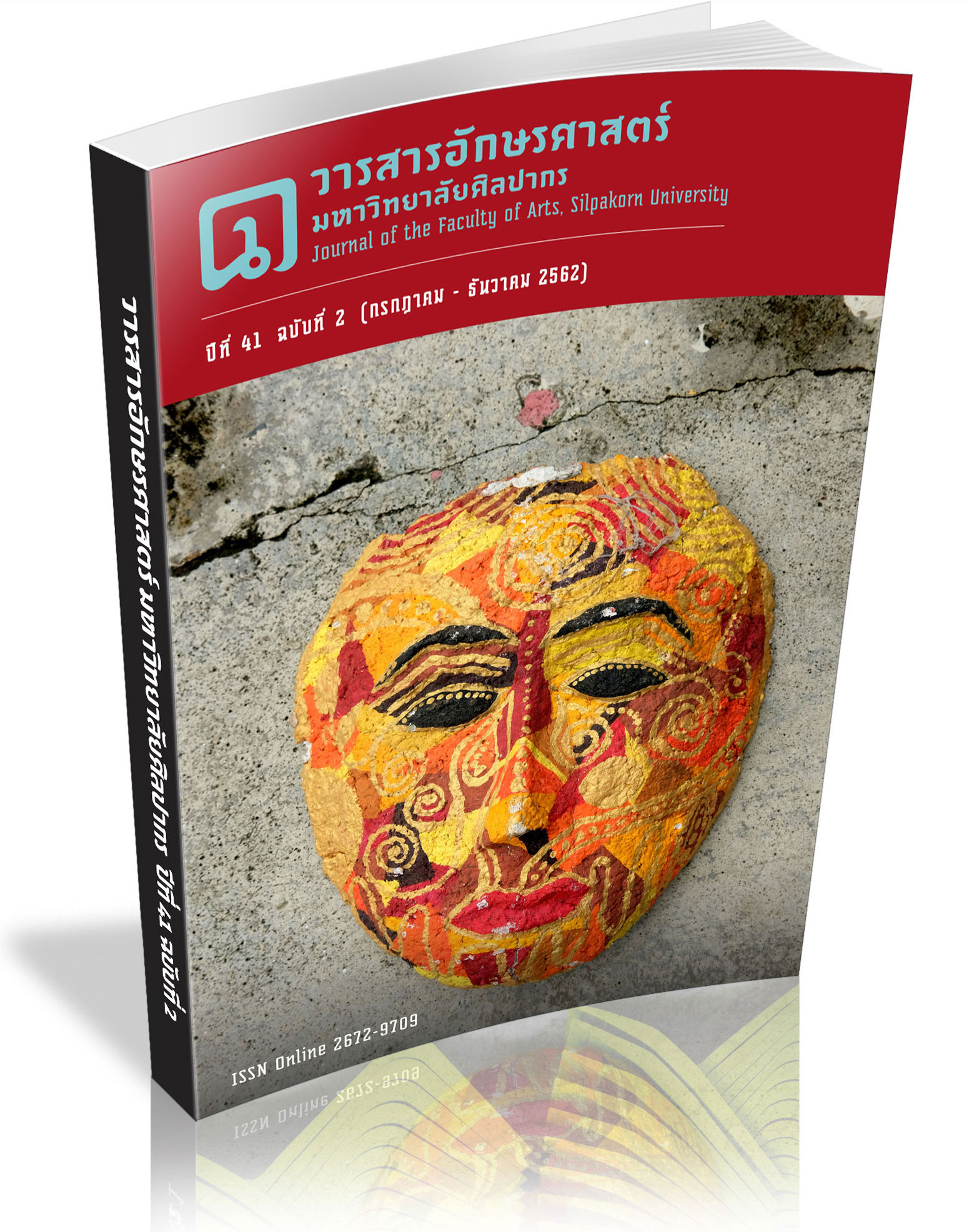The Contextual Meanings of the Preposition /kὲː/ in the Sukhothai Period
Keywords:
Contextual meanings, Conceptual meaning, Preposition /kὲː/, Sukhothai period, Cognitive semanticsAbstract
The objective of this article is to investigate the contextual meanings of the preposition /kὲː/ in the Sukhothai period within the cognitive semantics approach. The 61 data were collected from the book “The Inscription Collection Vol. 8: the Sukhothai Stone Inscriptions,” published by the Fine Arts Department in 2005. It is found that the preposition /kὲː/ in the Sukhothai period had 8 different contextual meanings. That is to say, the preposition was used to indicate 1) GOAL: abstract entity, 2) GOAL: emotional target 3) GOAL: transfer source 4) RECIPIENT (of things) 5) ADDRESSEE 6) POSSESSION: interpersonal relationships 7) RECIPINENT (of action) and 8) RECIPIENT (of attention) These 8 conceptual meanings had a shared conceptual meaning of ALLATIVE or GOAL marking. The results of this study indicated that the preposition /kὲː/ in the Sukhothai period is a polysemous word; and the contexts in which it occurred are
a contributing factor for its polysemous quality.
Downloads
References
Bandhumedha, N. (2016). Thai Grammar. 8th ed. Bangkok: Chulalongkorn University. (In Thai)
Brugman, C. A. (1983). A Story of Over. Master Thesis, University of California at Berkeley.
Brugman, C. A. & Lakoff, G. (1988). Cognitive Topology and Lexical Networks. In S. Small, G. Cottrell and M. Tanenhaus (eds.) Lexical Ambiguity Resolution: Perspective from Psycholinguistics, Neuropsychology and Artificial Intelligence, (pp.477 – 508). San
Mateo, CA: Morgan Kaufmann.
Croft, W. & Cruse, D. A. (2004). Cognitive Linguistics. Cambridge: Cambridge University Press.
Cruse, D. A. (2006). A Glossary of Semantics and Pragmatics. Edinburgh: Edinburgh University Press.
Crystal, D. (1985). A Dictionary of Linguistics and Phonetics. Oxford: Blackwell.
Deane, P. (1988). Polysemy and Cognition. Lingua, 73: 325 – 361.
Evans, V. (2019). Cognitive Linguistics: A Complete Guide. Edinburgh: Edinburgh University Press.
Evans, V. & Geen, M. (2006). Cognitive Linguistics an Introduction. Edinburgh: Edinburgh University Press.
Hiranras, J. (2007). A Semantics Study ‘TAKE’ in Thai. Masters Thesis, Linguistics Chulalongkorn University, Thailand. (In Thai)
Karius, I. (1989). Polysemy as an Instance of Lexical Regularity: Preposition. In G. Dunbar, B. Franks & T. Myers (eds.), Papers from the 1989 Edinburgh Round Table on the Mental Lexicon, (pp. 27 – 38). Edinburgh: Centre for Cognitive Science, University of Edinburgh.
Lakoff, G. (1987). Women, Fire and Dangerous things: What Categories Reveal About the Mind. Chicago: The University of Chicago Press.
Lakoff, G., & Johnson, M. (2003). Metaphors We Live By. Chicago: The University of Chicago Press.
Langacker, R. W. (2013). Essentials of Cognitive Grammar. New York: Oxford University Press.
Loannou, G. (2018). Constructions and Image-Schema Preservation: A Historical-Comparative Analysis of PAY in Greek and English. Lingua 206: 85 – 111.
Malchukov, A., Haspelmath, M. & Comrie, B. (2010). Ditransitive Construction: A Typological Overview. In Malchukov, A., Haspelmath, M. and Comrie, B. (Eds.), Studies in Ditransitive Construction a Comparative Handbook (pp. 1 - 64). Berlin / New York: De Gruyter Mouton.
Newman, J. (1996). Give: A Cognitive Linguistic Study. Berlin / New York: Mouton de Gruyter.
Office of the Royal Socieity. (2017). Linguistics Dictionary (General Linguistics) Royal institute Edition. Bangkok: Somnakngan. (In Thai)
Paholayuth, N. (1983). The Use of Prepositions in the Sukhothai, Ayudhya and Ratanakosin Periods: A Comparative Study. Masters Thesis, Linguistics, Chulalongkorn University, Thailand. (In Thai)
Poolrak, A. (2017). Khamthai-Khamthet Journal of Thai Language and Literature, 34 (1) (June): 135 – 153. (In Thai)
Pothipath, V. (2001). Analytic Causative Constructions in Thai. Masters Thesis, Linguistics, Chulalongkorn University. (In Thai)
Pothipath, V. (2014). The Development of Connectors in Thai. Thai Department, Faculty of Arts, Chulalongkorn University, Thailand. (In Thai)
Rattanaphanusorn, R. (2006). Semantic Extension of Visual Perception Verbs in Thai. Doctoral Dissertation, Linguistics, Chulalongkorn University. (In Thai)
Rice, S. & Kabata K. (2007). Crosslinguistic Grammaticalization Patterns of the ALLATIVE. Linguistic Typology. 11: 451 – 514.
Saralamba, C. (1995). A Concetual Study of /kὲː/. Doctoral Dissertation, Linguistics, Chulalongkorn University. (In Thai)
Song, J. J. (2010). Korean Benefactive Particles and their Meanings. In F. Zuniga & K. Seppo (eds.). Benefactives and Malefactives. Typological Perspectives and Case Studies (pp. 393 - 418). Amsterdam / Philadelphia: John Benjamins.
Stone Inscriptions. (2005). The Eighth Series of Stone Inscriptions: The Sukhothai Stone Inscriptions. Bangkok: Fine Arts Department. (In Thai)
The Royal Institute. (2013). Royal Dictionary 2011, in Honor of His Majesty King Bhumibol Adulyadej on the Auspicious Occasion of the 7th Royal Birthday Celebration, 5 December 2011. Bangkok: The Royal Institute. (In Thai)
Thepkanjana, K. (2010). Ditransitive Construction in Thai. In Malchukov, A., Haspelmath, M., & Comrie, B.(Eds.). Study in Ditransitive Constructions a Comparative Handbook (pp. 409 - 426). Berlin / New York: DE GRUYTER MOUTON.
Thepkanjana, K. (2016). Grammaticalization. Bangkok: Faculty of Arts, Chulalongkorn University. (In Thai)
Trask, R. L. (1993). A Dictionary of Grammatical Terms in Linguistics. London: Routledge.
Tyler, A. & Evans, V. (2003). The Semantics of English Prepositions Spatial Scenes, Embodied Meaning and Cognition. Cambridge: Cambridge University Press.
VanValin, R. D. & LaPolla, R. J. (1997). Syntax: Structure, Meaning, and Function. Cambridge: Cambridge University Press.
Vimuktalaba, V. (1970). The Change in the Meaning of Thai Words and Idioms and in Word Order during the Ratanakosin Period. Masters Thesis, Thai Language, Chulalongkorn University. (In Thai)
Wongsri, K. (2004). A Semantics Network of /kὲː/ in Thai: A Cognitive Semantic Study. Masters Thesis, Linguistics, Chulalongkorn University. (In Thai)
Downloads
Published
How to Cite
Issue
Section
License
ผู้เขียนบทความต้องยินยอมในข้อกำหนดต่าง ๆ ของวารสารก่อนส่งบทความตีพิมพ์




